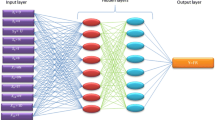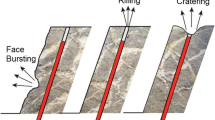Abstract
Flyrock, the propelled rock fragments beyond a specific limit, can be considered as one of the most crucial and hazardous events in the open pit blasting operations. Involvement of various effective parameters has made the problem so complicated, and the available empirical methods are not proficient to predict the flyrock. To achieve more accurate results, employment of new approaches, such as artificial neural network (ANN) can be very helpful. In this paper, an attempt has been made to apply the ANN method to predict the flyrock in the blasting operations of Sungun copper mine, Iran. Number of ANN models was tried using various permutation and combinations, and it was observed that a model trained with back-propagation algorithm having 9-5-2-1 architecture is the best optimum. Flyrock were also computed from various available empirical models suggested by Lundborg. Statistical modeling has also been done to compare the prediction capability of ANN over other methods. Comparison of the results showed absolute superiority of the ANN modeling over the empirical as well as statistical models. Sensitivity analysis was also performed to identify the most influential inputs on the output results. It was observed that powder factor, hole diameter, stemming and charge per delay are the most effective parameters on the flyrock.










Similar content being viewed by others
References
Abraham A (2004) Meta learning evolutionary artificial neural networks original research article. Neurocomputing 56:1–38
Bahrami A, Monjezi M, Goshtasbi K, Ghazvinian A (2011) Prediction of rock fragmentation due to blasting using artificial neural network. Eng Comput 27(2):177–181
Bajpayee TS, Rehak TR, Mowrey GL, Ingram DK (2004) Blasting injuries in surface mining with emphasis on flyrock and blast area security. J Safety Res 35:47–57
Bhowmik S, Raina AK, Chakraborty AK, Ramulu M, Sahu PB, Haldar A, Choudury PB, Srinivas P, Bandopadhyay C (2004) Flyrock prediction and control in opencast mines: a critical appraisal. Mining Eng J 5:6–10
Fausett L (1994) Fundamental of neural networks; architectures, algorithm and application, Prentice Hall International Editions edn. Prentice Hall, New York
Fletcher LR, D’Andrea DV (1986) Control of flyrock in blasting. In: Proceedings of 12th conference on explosives and blasting technique, Atlanta, Georgia, pp 167–177
Hornik K (1991) Approximation capabilities of multi layer feed forward networks. Neural Netw J 4:251–257
ISRM (1992) Suggested method for blast vibration monitoring. Int J Rock Mech Mining Sci Geomech Abstr 29:145–146
Institute of Makers of Explosives (IME) (1997) Glossary of commercial explosives industry terms, Safety publication, No. 12. Institute of Makers of Explosives, Washington, DC, pp 16
Jimeno CL, Jimeno EL, Carcedo FJA (1995) Drilling and blasting of rocks. Balkema, Rotterdam, pp 366–371
Kecojevic V, Radomsky M (2005) Fly rock phenomena and area security in blasting-related accidents. Saf Sci 43:739–750
Khandelwal M, Singh TN (2006) Prediction of blast induced ground vibrations and frequency in opencast mine—a neural network approach. J Sound Vib 289:711–725
Khandelwal M, Singh TN (2007) Evaluation of blast-induced ground vibration predictors. Soil Dyn Earthq Eng 27:116–125
Khandelwal M, Singh TN, Kumar S (2005) Prediction of blast induced ground vibration in opencast mine by artificial neural network. Ind Mining Eng J 44:23–29
Khandelwal M, Kumar DL, Yellishetty M (2011) Application of soft computing to predict blast-induced ground vibration. Eng Comput 27(2):117–125
Khandelwal M, Singh TN (2009) Prediction of blast induced ground vibration using artificial neural network. Int J Rock Mech Min Sci 46:1214–1222
Khandelwal M (2010) Evaluation and prediction of blast induced ground vibration using support vector machine. Int J Rock Mech Min Sci 47(3):509–516
Lundborg N (1973) The calculation of maximum throw during blasting. SveDeFo Rep DS 1973:4
Lundborg N, Persson A, Ladegaard-Pedersen A, Holmberg R (1975) Keeping the lid on flyrock in open-pit blasting. Eng Mining J 176:95–100
Massey JB, Siu KL (2003) Investigation of flyrock incident at clear water bay road on 6 June. Civil Engineering Department, the Government of the Hong Kong Special Administrative Region, Hong Kong, p 49
Maulenkamp F, Grima MA (1999) Application of neural networks for the prediction of the unconfined compressive strength (UCS) from equotip hardness. Int J Rock Mech Min Sci 36:29–39
Monjezi M, Bahrami A, Yazdian A (2009) Simultaneous prediction of fragmentation and flyrock in blasting operation using artificial neural networks. Int J Rock Mech Mining Sci 47:476–480
Monjezi M, Bahrami A, Yazdian A, Sayadi AR (2011) Prediction and controlling of flyrock in blasting operation using artificial neural network. Arab J Geosci 4(3–4):421–425
Monjezi M, Ahmadi M, Sheikhan M, Bahrami A, Salimi AR (2010) Predicting blast-induced ground vibration using various types of neural networks. Soil Dyn Earthq Eng 30:1233–1236
Neaupane KM, Adhikari NR (2006) Prediction of tunneling induced ground movement with the multi-layer perceptron. Int J Tunn Undergrad Space Technol 21:151–159
Raina AK, Chakraborty AK, Choudhury PB, Sinh A (2011) Flyrock danger zone demarcation in opencast mines: a risk based approach. Bull Eng Geol Environ 70:163–172
Verakis HC, Lobb TE (2003) An analysis of blasting accidents in mining operations. In: Proceedings of the 29th annual conference on explosives and blasting technique, vol 2, 2–5 Feb. International Society of Explosives Engineers, Cleveland, OH, pp 119–129
Author information
Authors and Affiliations
Corresponding author
Rights and permissions
About this article
Cite this article
Monjezi, M., Mehrdanesh, A., Malek, A. et al. Evaluation of effect of blast design parameters on flyrock using artificial neural networks. Neural Comput & Applic 23, 349–356 (2013). https://doi.org/10.1007/s00521-012-0917-2
Received:
Accepted:
Published:
Issue Date:
DOI: https://doi.org/10.1007/s00521-012-0917-2




